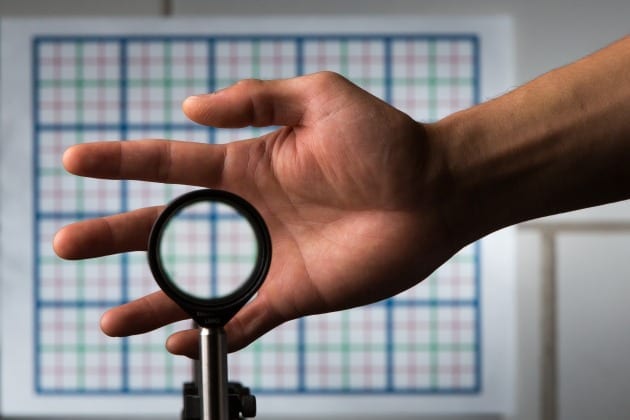
photo by J. Adam Fenster / University of Rochester
Optical cloaking allows objects to be hidden in plain sight or to become invisible by guiding light around anything placed inside the cloak. While cloaking has been popularized in fiction, like in the “Harry Potter” books, researchers in recent years have started realizing cloaks that shield objects from view by controlling the flow of electromagnetic radiation around them.
In the Journal of Applied Physics, by AIP Publishing, researchers from the Toyota Research Institute of North America examined recent progress of developing invisibility cloaks that function in natural incoherent light and can be realized using standard optical components, part of ongoing research over the last two decades.
Invisibility cloaks potentially have a broad array of applications in sensing and display devices in warfare, surveillance, blind spot removal in vehicles, spacecraft, and highly efficient solar cells. The researchers examined blind spots that occur in vehicles, such as the windshield pillars, the stanchions that frame windshields.
“We are always looking for ways to keep drivers and passengers safe while driving,” said author Debasish Banerjee. “We started exploring whether we could make the light go around the pillar so it appeared transparent.”
Advances in metamaterials, engineered complexes of metals and dielectrics for manipulating electromagnetic waves, have opened up the possibility for realizing optical cloaks around an object by making incoming light bypass it.
Perfect optical cloaking requires the total scattering of electromagnetic waves around an object at all angles and all polarizations and over a wide frequency range, irrespective of the medium. This has not yet been achieved.
However, by simplifying the invisibility requirements, innovative work with spherical transformation cloaks, carpet cloaks, plasmonic cloaks, and mantle cloaks in narrowband microwave, infrared, and optical wavelengths has been accomplished over the last two decades.
“One of the real challenges is that we have to optimize optical elements around an object so that phase relationships are preserved,” said Banerjee.
For optimization, artificial intelligence and machine learning may help resolve certain challenges. Algortihms can help solve the necessary inverse design problem in the context of practical cloaking devices.
These can be powerful tools to predict and analyze the optical responses of these devices or detectors without time-consuming and expensive simulations, which may raise the possibility of intelligent invisibility that is adaptive to movements, shapes, and the environment.
With the fast development of both AI-aided design and additive manufacturing capabilities, it is foreseeable that flexible cloaks that could function effectively at all incident angles with a high cloaking ratio and a wide field of view could be realized and mass-produced at low cost and high efficiency.
Original Article: Bending Light for Safer Driving; Invisibility Cloaks to Come?
More from: Toyota Research Institute
The Latest Updates from Bing News & Google News
Go deeper with Bing News on:
Optical cloaking
- One of Our Favorite Superpowers Is Now a Real Possibility: Invisibility Shield 2.0
That's because a group of engineers and scientists, or as I like to call them, optical illusionists, has been working on what you see for over the past four years. Now, invisibility or cloaking ...
- Zenni Optical Promo Code + Coupons May 2024
More information Enhance your comfort, style, and vision with 75% off the trendy Lightweight Aviator Glasses, now just $7 when you apply this Zenni Optical promo code during checkout. Get high ...
- The Best Compact Binoculars of 2024, Tested and Reviewed
A compact 8×32 binocular, with good glass and glare-cutting coatings, has nearly the same optical horsepower of older 10x42s. Also, their smaller frame weighs less, boasts a wider field of view, tucks ...
- Realization of an ideal omnidirectional invisibility cloak in free space
A team led by Prof. Dexin Ye and Prof. Hongsheng Chen from Zhejiang University, and Prof. Yu Luo from Nanyang Technological University conducted research on the practical implementation of ...
- Going all optical
"TPUv4 accelerators are deployed in 'SuperPods' of 4,096 chips, each connected to a dedicated optical switch, which can dynamically reconfigure 4x4x4 chip cubes into arbitrary 3D torus topologies in ...
Go deeper with Google Headlines on:
Optical cloaking
[google_news title=”” keyword=”synthetic molecular motors” num_posts=”5″ blurb_length=”0″ show_thumb=”left”]
Go deeper with Bing News on:
Invisibility cloaks
- One Hogwarts Legacy Quest is an In-Joke For Movie Fans
One particular Hogwarts Legacy quest serves as an in-joke to Harry Potter and the Chamber of Secrets and Ron Weasley's legendary phobia.
- MPO’s Harry Potter Concert Tickets Vanish Faster Than A Golden Snitch: Sold Out Within Hours Of Release
Within mere hours of their release, the coveted tickets had been snatched up by eager fans, leaving Potterheads across the nation desperately seeking a way to attend the enchanting event.
- A Week On The Stealth Wealth Yacht Luring The Jet Set To The Galápagos
The animals, unbothered by human overload, are so quiet and non-fussed by the presence of half a dozen travellers it is as if one is wearing an invisibility cloak. The only rules – whether it be ...
- Star Wars Day 2024 Singapore: All The Festivities From May The 4th To 19th
Singapore gears up to celebrate Star Wars Day 2024 from May the 4th to the 19th, ready to host events that will thrill fans of the franchise.
- Startup raising money to manufacture invisibility shields
The shield was developed by the London-based startup Invisibility Shield Co. and has already raised £148,680, or just over $184,000, on the crowdfunding platform Kickstarter. With a month still left ...
Go deeper with Google Headlines on:
Invisibility cloaks
[google_news title=”” keyword=”invisibility cloaks” num_posts=”5″ blurb_length=”0″ show_thumb=”left”]










